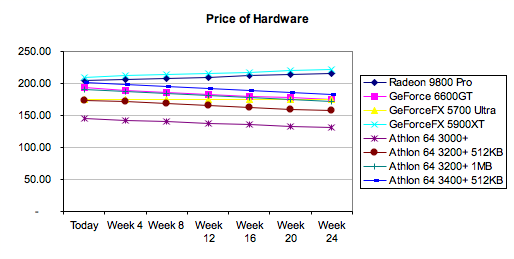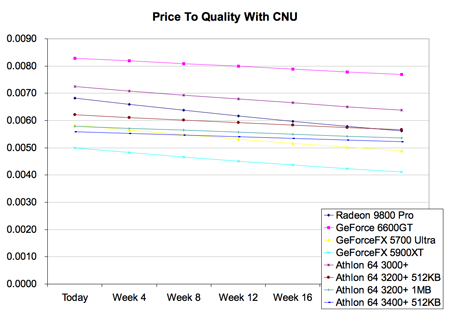Beating the System: The AnandTech Guide to Economic Upgrading
by Kristopher Kubicki & Jarred Walton on January 30, 2005 5:59 PM EST- Posted in
- Guides
Putting it all together
So far, we showed how easy it was to build a model with retrospect data and how easy it was to build a model with made up continuous data. The goal now is to build a hybrid model from the previous two. Below is a list of hardware from the previous example, but using continuous devaluation overrides to "predict" the cost of each product after every four weeks.
| Quality Assumptions | Devaluation Override | |
| Radeon 9800 Pro | 200.00% | -1.00% |
| GeForce 6600GT | 240.00% | 1.67% |
| GeForceFX 5700 Ultra | 100.00% | 0.00% |
| GeForceFX 5900XT | 170.00% | -1.00% |
| Athlon 64 3000+ | 105.00% | 1.67% |
| Athlon 64 3200+ 512KB | 108.00% | 1.67% |
| Athlon 64 3200+ 1MB | 110.00% | 1.67% |
| Athlon 64 3400+ 512KB | 113.00% | 1.67% |
Again, continuous functions are bad for attempting to predict hardware pricing trends because pricing models for most components are structured on a discrete stair step algorithm using various price points. For those of you familiar with our pricing guides or the RTPE, you'll know that we watch a lot of prices at any one time. Purav, Adul and I can recite the exact distributor MRSP on every Intel processor at any given moment. We notice specific trends that can be readily identified with our historical data in the Real Time Engine (the graphs). Generally, after a new product has stabilized in price a little bit, a new processor, motherboard or video card will continue to devalue about 1.67% per month until the products retail EOL. Low demand products that hit EOL cling to their MSRP for a while (thus 0% devaluation) while high demand products will actually start to increase in price due to supply and demand (usually less than 1% per month). The Radeon 9800 Pro is actually a very good example of a video card that went through all three phases during its lifetime as a retail product. When all else fails, be a little too conservative with your estimates; the only thing that the devaluation should affect is whether or not it makes sense to upgrade today.
With some quick calculations, we can generate the estimated prices for the next six months based on today's hardware prices and the devaluation overrides that we just discussed above. The resulting graph looks as such:

Now, we can introduce our CNU value of $0.25 per day again and replot the graph.

It should be pretty clear which hardware not to buy at this point; buying a GeForce 5900XT six months from now (if you can still find one) will cost you double, since you are paying for the retailers to mark up the price on their remaining stock even before taking into consideration the CNU. Adding the relative Quality for each product gives us the final plot below.
Just based on mathematical formulas and some educated assumptions for relative Quality, the GeForce 6600GT comes out on top again with the Radeon 9800 Pro a mildly distant second. Upgrading the processor instead of the graphics card might actually make sense in this scenario (after the 6600GT) with the weights that we've given based on HL2 CPU and GPU scaling. All of the data from this page can be viewed in the second excel workbook from the spreadsheet available here.











50 Comments
View All Comments
arud - Sunday, January 30, 2005 - link
Poser - Sunday, January 30, 2005 - link
I've been thinking about upgrading my computer for the past 6 months or more. Gutting it, really, since once the motherboard goes, most of the other components will get upped too to prevent dumb bottlenecks -- I'm looking at around six to seven hundred dollars worth of upgrades. But, the thing that's held me back ISN'T waiting for the next big thing, or for prices to drop, it's that upgrading to Half-Life 2 or Doom 3 grade hardware is worth AT MOST $150.I love this site, I consider computer hardware to be a genuine hobby, but I can't justify to myself spending more than that on playing FPS video games. The price of a good PC gaming rig is so completely out of line with what it'd cost to just pick up an Xbox that I suspect I'll be sticking with strategy games for a very long time... that or buying a current or next gen console.
Eventually, I might find some "killer app" that is actually hardware-intensive (usably good speech recognition software with excellent OS integration?), but for the moment the only thing I do that challenges even my old 1400+ Athlon XP is gaming. I just can't bring myself to think that gaming on a PC is valuable enough to justify dropping the money.
This article was a cool read, because if nothing else, it made me think to put a number on how much I really would "value" or pay for better hardware.
Dragonbate - Sunday, January 30, 2005 - link
LOL I can't help but think this article was a farce.cosmotic - Sunday, January 30, 2005 - link
Next time maybe you should tell us what we should do. Like "If this is your setup, the average person would upgrade HERE" and give what you would upgrade to. This is like trying to sell something to some one but then never actually asking them if they want to buy it. You have all these details and then no real conclusion. When SHOULD I upgrade? I have no idea, and it's not worth my time to read all this stuff and then figure it all out. Again, a nice conclusion with a concrete example would be nice. And some else that would be nice would be like arrows on the graphs that say "this is when you should upgrade and for reason X, Y, and Z". The graphs mean nothing without an explination or point.Dranzerk - Sunday, January 30, 2005 - link
I think the single hardest part of a PC is upgrading. If we did not have PC games how many here would be running the latest hardware? I would upgrade once every 2 years, instead of buying new hardware little at a time every month to make a new pc every 6 months. lolgaidin123 - Sunday, January 30, 2005 - link
Great article! Granted most people won't actually do the formulas but this is a great article to link to when people moan about waiting for the next big thing. ;)Of course if you *need* the next big thing for the purpose you will use the computer for (ie SATAII or 802.11n) you have to wait...
Gaidin
archcommus87 - Sunday, January 30, 2005 - link
But how is this reliable? The quality percentages are for one application only and even then are very estimated. And the cost per day of one quarter of NOT upgrading can vary greatly. If I'm gaming fine just now I'm not losing out on anything by not upgrading yet.MarkM - Sunday, January 30, 2005 - link
Also, I think I might add, this is a hobby for most people, not a business. The whole point is to have fun, and sometimes the excitement of researching the new hardware is the best part. A cost/benefit analysis reduces the biggest benefit for some, the fun.MarkM - Sunday, January 30, 2005 - link
Uhh ... that was interesting. Man, I'm an ANALYST for my career, I write cost/benefit analyses all the time, and even I was skimming by the last few pages of that!The one variable you didn't figure in (I think?) was the evaluator's time. Spending hours of your time calculating whehter it's workth it to spend the extra $50 may not be cost effective, in the gneral sense of resource cost. One thing I learned very early in my career is that there is a cost/beniefit ratio even in preparing the cost/benefit. If it is a relatively minor outlay, you need to apply heuristics over full blown analysis.
Still, I think this is perhaps a good intro to peopel not used to thinking in this way.
deathwalker - Sunday, January 30, 2005 - link
Ah...the benifits of being an impulse buyer. I don't have to worry about stuff like this. If you want it...get it...trash the formulas.